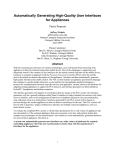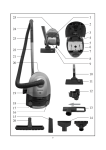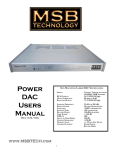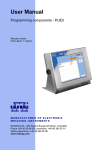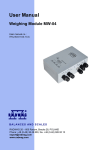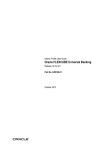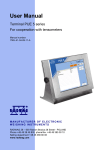Download Abstract--Today`s complex appliances are plagued
Transcript
Studying The Use of Handhelds to
Control Smart Appliances
Jeffrey Nichols and Brad A. Myers
Human Computer Interaction Institute
School of Computer Science
Carnegie Mellon University
Pittsburgh, PA 15213
{jeffreyn, bam}@cs.cmu.edu
Abstract— Today’s complex appliances are plagued by difficultto-use interfaces. In many cases, consumers use only a few of the
many features on their appliances because the more complex
features are hidden by confusing interfaces. This problem can
only get worse as appliances get smarter, become more complex,
and are subject to more demands by their users. This paper
presents two studies that compare the accuracy and speed of real
users controlling two common appliances, a stereo and a
telephone/answering machine, using two different interaction
techniques. Our studies found that people using an appliance
interface presented on a handheld computer performed the same
set of tasks in half the time while making half the errors as
compared to using the appliance’s built-in control panel. These
studies are motivating us to build a generic remote appliance
control system that we call the personal universal controller.
1
Introduction
Appliances available today are becoming increasingly
complex. Unfortunately for users, the trend has been that as
these appliances get more complex, their interfaces become
harder to use [1]. This is occurring in part because it is cheap
for manufacturers to embed powerful processors and add new
features, but it is expensive to design a high quality user
interface that accommodates all of the new features.
Making user interfaces for the smart appliances of the future
will be even more difficult and expensive for several reasons:
1) Smart appliances will be even more complex than today’s
appliances, and thus the interface design task will be more
difficult. 2) Smart appliances may be able to update their
functionality, perhaps by downloading code for new features
over the Internet. The interface for the smart appliance will
need to be flexible enough to present these new features in a
usable way. 3) Users will want to remotely control their
appliances from great distances, such as controlling a device at
home from the workplace. 4) Users may want to combine the
interfaces of multiple smart appliances into a single taskspecific user interface. For example, the user might want to
have a set of controls for their living room that combine the
interfaces of their DVD player, television, and stereo system.
We are developing the personal universal controller (PUC),
a technology that will solve these problems by letting users
interact with intermediary interfaces as though they were using
remote controls. We imagine that PUCs will run in a variety of
locations through multiple interface modalities, perhaps as
graphical interfaces on personal digital assistants (PDAs) or
speech interfaces on hidden household computers. Unlike the
remote controls of today, the PUC is self-programming. This
means that the PUC engages in a two-way exchange with the
appliance, downloading a specification of the appliance’s
functions and then automatically generating a high-quality user
interface. The two-way communication between the PUC and
the appliance continues as the user interacts with the interface,
allowing the PUC to send command signals to the appliance
and show feedback of the appliance’s state.
The PUC will solve several of the problems that we
anticipate for the interfaces of smart appliances. Since
appliance interfaces are automatically generated, the appliance
may upgrade its features at any time and the interface will
update to reflect the new features. A PUC interface can also be
used anywhere, provided a network connection can be made to
the appliance. This allows a PUC to remote-control appliances
from a distant location. Remote control is made easier because
feedback on the appliances’ states is provided by the two-way
communication, which means that users will not be blindly
controlling appliances.
We also believe that the PUC will be able to deal with the
complexity of an appliance’s features better than an interface
on the appliance itself, because PUC interfaces are being
generated in a richer interface environment than is possible to
provide on an appliance. In this paper we present two studies
that compare user accuracy and speed using interfaces on a
PDA versus using the interfaces on the actual appliances. Our
studies show that users were twice as fast and made half the
errors when using the PDA interface as compared to the actual
appliances. This difference can be attributed to the lack of
flexibility given the designers of the actual appliances.
This paper begins by describing some work related to the
PUC project. We then describe our approach to creating a
system that automatically generates high quality interfaces. We
continue by describing the user studies, their results, and
discuss how these results are helping us build a system that
automatically generates user interfaces. We conclude by
briefly describing the current state of the PUC project and our
directions for the future. Prior papers have described the PUC
system in more detail [4, 5], but this is the first description of
the user studies that motivated our work.
2
Related Work
A number of research groups are working on controlling
appliances from handhelds. The Stanford ICrafter [7] is a
framework for distributing appliance interfaces that supports
automatic generation of interfaces. The focus of this project
was on the infrastructure however, and [7] shows only one low
quality automatically generated interface. The XWeb project
[6] automatically generates interfaces with complex layouts,
however their interfaces do not seem to handle modes well,
which is an important part of building interfaces for
appliances. The importance of handling modes will be seen
later in this paper, in the discussion of the user studies.
Work has also been done previously on the automatic
generation of generic user interfaces for any application, but
most of these systems created only outlines of interfaces and
required significant work by the designer to make them usable
[2, 8]. This will not be suitable for our purposes, because our
system is targeted at consumers instead of interface designers,
and users cannot be expected to spend time to improve the
generated interfaces.
The INCITS V2 [9] standardization effort is developing the
Alternative Interface Access Protocol (AIAP) to help people
with disabilities interact with everyday appliances. This work
is very similar to our PUC protocol, and we are now
collaborating closely with this group. Research results from
our PUC project have already significantly affected the
direction of the V2 effort.
3
Approach
Automatically generating high quality user interfaces is a
hard problem, as shown above in the related work section. As
a first step toward automatically generating remote control
interfaces, we hand-designed control panels for two
appliances, evaluated them for quality, conducted the two user
studies reported here, and then attempted to extract the
features of these control panels that contribute most to their
usability [5]. This approach allows us to understand the
features that a high quality remote control interface will have,
and then apply them in our interface generator software [4].
We chose two common appliances as the focus of our handdesigned interfaces: the Aiwa CX-NMT70 shelf stereo with its
remote control (see Figure 1a) and the AT&T 1825
telephone/digital answering machine (see Figure 1b). We
chose these two appliances because both are common, readily
available, and combine several functions into a single unit.
The first author owns the Aiwa shelf stereo that we used, and
the AT&T telephone is the standard unit installed in many
offices at Carnegie Mellon. Aiwa-brand stereos seem to be
particularly common, at least among our subject population,
because ten of our twenty-five subjects owned Aiwa systems.
4
created and the interfaces on the actual appliances. We
measured the performance of the subjects using several
metrics, including the time to complete a task, the number of
errors made while attempting to complete a task, and how
often external help was required to complete a task. The
purpose of these studies was to discover how users performed
using our hand-designed interfaces versus the interfaces of the
actual appliances and discover what aspects of the handdesigned interfaces were difficult to use.
4.1
Procedure
When each subject arrived, they were asked to fill out a
consent form and a two-page questionnaire about their
computer background and remote control use. Then each
subject worked with two interfaces in one of four possible
combinations to control for order effects. Each subject saw one
actual interface and one handheld interface, and one stereo
interface and one phone interface, neither necessarily in that
order. For each interface, the user was asked to work through a
set of tasks. When finished, a final questionnaire was given
that asked whether the actual appliance or PDA interface was
preferred and for any general comments about the study and
the interfaces.
4.2
Evaluation
In order to compare the interfaces for both appliances, task
lists were created for the stereo and phone. Each list was
designed to take about twenty minutes to complete on the
actual appliance, and the same tasks were used for both the
handheld and actual interfaces. About two-thirds of the tasks
on both lists were chosen to be easy, usually requiring one or
two button presses on the actual appliance. Some examples of
easy tasks are playing a tape on the stereo, or listening to a
particular message on the phone. The remaining tasks required
five or more button presses, but were chosen to be tasks that a
user was likely to perform in real life. These included
programming a list of tracks for the CD player on the stereo, or
setting the time on the phone.
We anticipated that some subjects would not be able to
complete some of the more difficult tasks. If a subject gave up
while working with the actual phone or stereo, they were given
the user manual and asked to complete the task. Subjects
working on the prototype interfaces were allowed to press the
User Studies
Both studies that we conducted were between-subjects
comparisons of the hand-designed PDA interfaces that we
(a)
(b)
Figure 1. a) The Aiwa CX-NMT70 shelf stereo and b) the AT&T 1825
office telephone/digital answering machine used in our research.
(a)
(b)
Figure 2. Interfaces for the phone (a) and stereo (b) hand-designed for the
Palm. These interfaces are paper prototypes.
“Help” button, available in some form on every screen. On the
paper interfaces for the first study, a verbal hint was given,
whereas the Visual Basic interfaces for the second study
presented a scrollable screen of text, indexed by topic.
The performance of each subject on both lists of tasks was
recorded using three metrics: time to complete the tasks,
number of missteps made while completing the tasks, and the
number of times external help was needed to complete a task.
The time to complete the tasks was measured from the press of
the first button to the press of the button that completed the
last task. External help is any use of the manual for an actual
appliance or the help screen on the PDA, or any verbal hint
from the experimenter.
For the purposes of this study, a misstep is defined as the
pressing of a button that does not advance progress on the
current task. Repeated pressings of the same button were not
counted as additional missteps. Sometimes a subject would try
something that did not work, try something else, and then
repeat the first thing again. If the interface had given no
feedback, either visibly or audibly, the repeated incorrect steps
are not counted as additional missteps. No missteps are
counted for a task after the user has requested external help.
5
Study #1
The first study compared the actual appliance interfaces to
paper prototypes of our hand-designed interfaces. Two
examples of these interfaces are shown in Figure 2. The
interfaces were also designed to be functionally equivalent
with the appliance they were meant to control.
For the handheld portion of our experimental procedure,
subjects were given a piece of paper that showed a picture of a
Palm V handheld device displaying the remote control
interface. Subjects were instructed to imagine that the picture
was an actual handheld, and to interact with it accordingly.
Whenever the subject tapped on an interface element on the
screen, a new picture was placed over the old one to show the
result of the action. If auditory feedback was required, such as
when the subject pressed play on the CD panel of the stereo
(see Figure 2b), the test administrator would verbally tell the
subject what happened.
Figure 3. Box-plots showing the range of missteps and help requests
(uses of external help) for each appliance and interface type.
5.1
Participants
Thirteen Carnegie Mellon graduate students volunteered to
participate in this study, five female and eight male. All
subjects were enrolled in the School of Computer Science, and
all had significant computer experience. Seven owned Palm
devices at the time of the study. Only one subject had no Palm
experience and the remaining five had exposure to Palm
devices in class or through friends. Everyone in the group had
some experience with stereo systems. Only two did not have a
stereo. Four subjects happened to own a stereo of the same
brand used in this study.
5.2
Results
The results of the study indicate (all p < 0.001) that subjects
made fewer missteps and asked for help less using the
prototype handheld interfaces than using the actual appliances
(see Figure 3). This indicates that the prototype handheld
interfaces were more intuitive to use than the actual interfaces.
Time was not recorded for this study because we believed
that delays created by the paper prototypes would dominate the
time required to complete all the tasks. Even so, informal
measurements suggested that subjects needed about one-half
the time to complete all of the tasks using the prototypes as
compared to the actual appliances.
5.3
Discussion
We found that users had great difficulty using the actual
appliances, but were able to understand and operate the paper
prototype interfaces with reasonable ease. One exception to
this was found in the prototype stereo interface, which made
use of the Palm’s built-in menu system. None of our subjects
navigated to screens that were only accessible through the
menus without help, because they did not think to press the
button that makes the menus visible. This was in spite of the
fact that more than half used Palm devices regularly and were
aware of the menu system. Although the study was successful,
we were concerned that the prototype interfaces benefited from
the close interaction of the subject and the experimenter. In the
paper prototype portion of the study, the experimenter
provided all feedback to the user, including verbal hints when
the user requested them. Because of these issues, we decided
to conduct a new study with full implementations of the
interfaces so that the experimenter would be a passive observer
instead of an active participant.
6
Study #2
The second study improved upon on the first study by
replacing the paper prototypes with working prototypes. We
created interfaces for the stereo and phone that run on a
Microsoft PocketPC using Visual Basic. These interfaces were
based on the prototype interfaces for the Palm, but were
modified to conform to the interface conventions of the
PocketPC (see Figure 4). We chose the PocketPC instead of
the Palm because of the availability of Microsoft’s eMbedded
Visual Basic tool, which made the implementation relatively
painless.
Unfortunately, it was not possible to use the PocketPC to
actually control either of our appliances, but we still wanted
the subjects to receive feedback from their actions in a manner
that was consistent with the appliances, without involving the
experimenter. We chose to simulate control using wireless
communication from our PDA to a laptop. The laptop was
connected to external speakers, and it generated auditory
feedback that was consistent with what would be expected if
the PocketPC were actually controlling either of the
appliances.
Because of the complexity of both appliances, the PocketPC
interfaces required more than fifty hours of design and
implementation effort to create. They were improved over
several iterations using a combination of heuristic analysis and
think-aloud studies with pilot users.
One very important issue with the PocketPC interfaces was
their use of several conventions that are specific to the
PocketPC operating system. In particular, there is a standard
OK button for exiting dialog boxes that is displayed in the top
right corner of the screen. Users in pilot tests did not discover
this feature, and thus were unable to exit from certain screens
in the interface. Because one of our goals is to use the
conventions of the controlling device to guide interface
generation, we chose not to change the interfaces. Instead, we
created a tutorial program that we presented to subjects before
they began the study. The tutorial covers the OK button, textentry, and the location of the menu bar, which is at the bottom
of the screen instead of the top as on desktop computers.
6.1
Participants
Twelve students from Carnegie Mellon volunteered to
participate in the study, in response to an advertisement posted
on a high-traffic campus newsgroup. The advertisement
specifically requested people with little or no knowledge of
handheld computers. Subjects were paid US$7 for their
participation in the study, which took between thirty and forty-
(a)
(b)
Figure 4. Interfaces for the phone (a) and stereo (b) hand-designed for the
PocketPC. These interfaces were actually implemented in Microsoft's
eMbedded Visual Basic.
five minutes to complete. Eight men and four women
participated, with a median age of 22 and an average of five
years experience using computers. Subjects self-rated their
skill at using computers for everyday tasks and their
knowledge of handheld computers on a seven-point Likart
scale. On average, subjects rated their knowledge of handhelds
three points less than their skill with everyday computers (an
average of 5.5 for everyday skill and 2.5 for handheld
knowledge). Half the group owned Aiwa-brand stereos and
two had AT&T digital answering machines.
6.2
Results
The results of the study indicate that subjects performed
significantly better (p < 0.05 for all) using the PDA interfaces
in all three metrics: time to complete the tasks, number of help
requests, and number of missteps. Note that we were able to
measure time in this study because there was no longer time
overhead from shuffling papers. Figure 5 shows box-plots
comparing the handheld and actual interfaces for each metric
on the stereo and phone respectively.
For both appliances, users of the actual interfaces took
about twice as long, needed external help five times more
often, and made at least twice as many mistakes as users of the
PDA interfaces.
6.3
Discussion
The results of the second study are very similar to those of
the first. Most of our subjects did not need to use external help
to complete tasks using the handheld, and those that did use
help only used it once. This compares to each subject’s
average of 3.6 uses of help for the actual stereo and 4.3 uses
for the actual phone. Poor labeling, insufficient feedback, and
the overloading of some buttons with multiple functions can
account for this large difference on the actual appliances.
The worst examples of poorly labeled buttons and
overloaded functions were found on the AT&T phone. This
phone has several buttons that can be tapped quickly to
activate one function and be pressed and held to activate
another function. There is no text on the telephone to indicate
this.
A similar problem is also encountered on the stereo. Setting
the timer requires the user to press a combination of buttons,
each button press within four seconds of the last. The stereo
does not display an indicator to warn of this restriction, and
often users were confused when a prompt would disappear
when they had not acted quickly enough.
The phone also suffered from an underlying technical
separation between the telephone and the answering machine
functions. None of the buttons on the phone can be used with
the answering machine. Even the numeric codes must be set
using arrow buttons rather than the phone keypad. All but one
subject tried to use the keypad buttons to set the code. The
exception had used a similar AT&T phone in the past.
All of these problems were avoided in the PDA interfaces,
because there was room for labels that were more descriptive
and certain multi-step functions could be put on a separate
screen or in a wizard. Using different screens to separate
infrequently used or complex functions can also be
problematic, however. Other buttons or menu items must be
provided so that the user can navigate between screens, and the
labels for these navigation elements must describe the general
contents of the screen that they lead to. This was particularly a
problem for the handheld stereo interface, which has more than
ten screens. Many of the screens are accessible through the
menu bar at the bottom of the screen. Subjects in the study and
think-aloud participants before the study were very tentative
about navigating the menus to find a particular function. In
tasks that required the subject to navigate to a screen from the
menu bar, the subject commonly opened the correct menu,
closed the menu, did something wrong on the current screen,
and then opened the menu again before finally picking the
correct item.
The PDA stereo interface had other problems as well. In
particular, we found that the record function was difficult to
Figure 5. Box-plots of results from the second user study.
represent in the interface because it was associated with tapes
but needed to be available in all of the stereo’s five playback
modes: tape, radio, CD, etc. Although a record button was
available on every screen (see Figure 4b), many subjects
would get confused and incorrectly switch to the tape mode
instead of pressing the record button. The red circle next to the
text label on the “Rec” button was added after pilot testing to
make the button more visible, because we thought that people
tried the tape mode because they did not see the record button.
This change seemed to have little effect, however.
The prototype interfaces showed that finding functional
groups is important for constructing a good interface. These
groups define how elements are placed relative to each other,
and which elements can be separated across multiple screens.
The different screens of the tab components are the best
examples of grouping in our prototype interfaces (see Figure 2
and Figure 4). Grouping is also used to separate the mode,
random, and repeat elements from the rest of the elements of
the stereo CD player interface (see Figure 2b). These elements
are used in all of the CD player’s modes, while the other
components are only used in half the modes.
Unfortunately, the visual groups cannot be specified
explicitly because their members may vary between target
platforms. For example, on a device with a small screen it
might be necessary to separate the display of the current disc
and track from the controls for playing a CD. It would not be
appropriate if the PUC separated the play and stop buttons
however. We have found that we can specify this grouping
information to the interface generators by combining a tree
structure of the appliance’s functions with dependency
information. Dependency information defines when each
function will be active in terms of the other functions.
Knowledge of dependencies is particularly useful for
determining visual groups, as it can be used to separate
controls that are only available in certain modes, as we saw in
the stereo CD player interface.
The prototype interfaces also showed that feedback is
important. One important way the interfaces provided
feedback was by disabling, or graying out, a control so the user
could tell when that function was not available. Many of the
errors users made with the actual appliance interfaces occurred
when they pressed buttons for functions that were not currently
available. This is another area where dependency information
is helpful, because it defines exactly when the control(s) for a
function should be disabled.
One problem for interface generators is dealing with the
conventions that we are familiar with in our daily lives. For
example, both the actual phone and our PDA phone interface
used the standard layout for a phone dialing pad (see Figure
2a). These conventions should not be specified as a part of the
functional description of the appliance however, because they
are not always applicable. The dialing pad convention does not
make any sense for a speech interface, for example. We plan to
solve this problem by defining high-level types in our language
that may not be understood by every interface generator.
Those generators that do understand the type can apply the
appropriate convention, and those that do not will be able to
query the appliance further to understand the primitive
components of the high-level type.
Another problem for interface generators is determining
when it makes sense to have multiple elements of the
specification language be instantiated as a single widget. The
prototype PocketPC interface for the phone does this, by using
the same scrollbar to set the volume of the speakerphone and
the handset, depending on which is currently in use (see Figure
4a). One solution would be to use this technique when two
functions have similar types and are never used together. We
plan to investigate the generalness of this solution as a part of
our future work.
7
consistency across interfaces for similar appliances. In this
way, for example, users could leverage their knowledge of a
VCR they have used in the past to use a different VCR that
they have never seen. We are also planning to integrate our
system with some of the appliance control protocols that are
emerging, such as UPnP and HAVi.
8
This paper has described two user studies that showed users
were able to control an appliance using PDA interfaces twice
as fast, while making half the errors as compared to using
actual appliance interfaces. These studies show that PDAs,
with their rich interface capabilities, are a promising direction
to explore for appliance control. The prototype interfaces
created for these studies provide insights into the important
aspects of making highly usable control panels. The results of
these studies suggest that it may be possible to make complex
appliances usable with the PUC approach.
Acknowledgments
This work was conducted as a part of the Pebbles project [3]. Marc
Khadpe did a portion of the work on the prototype phone interface as a part of
a summer independent study project. This work was funded in part by grants
from NSF, Microsoft and the Pittsburgh Digital Greenhouse, and equipment
grants from Symbol Technologies, Hewlett-Packard, and Lucent. The
National Science Foundation funded this work through a Graduate Research
Fellowship for the first author, and under Grant No. IIS-0117658. Any
opinions, findings, and conclusions or recommendations expressed in this
material are those of the authors and do not necessarily reflect those of the
National Science Foundation.
References
[1]
[2]
Current Status and Future Work
From the lessons of these studies, we developed a set of
requirements for any system that automatically generates
remote control interfaces [5]. We then designed a language for
specifying the functions of an appliance and built two interface
generators that automatically create graphical and speech user
interfaces [4].
Our system can also control real appliances using two-way
communication, such as a Sony digital camcorder, an
Audiophase shelf stereo, a Mitsubishi VCR, X10 lighting, and
the software media players Winamp and Windows Media
Player. We communicate with these appliances by building
appliance adaptors, which are custom hardware and software
that translate the proprietary protocol of the appliance to our
PUC protocol.
Much work remains to be done on this project. We would
like our interface generators to create more aesthetic
interfaces, and to take into account the preferences of the user
during generation. We would also like our generators to ensure
Conclusion
[3]
[4]
[5]
[6]
[7]
[8]
[9]
Brouwer-Janse, M.D., et al. “Interfaces for consumer products: "how to
camouflage the computer?"” in CHI'1992: Human factors in
computing systems. 1992. Monterey, CA: pp. 287-290.
Kim, W.C. and Foley, J.D. “Providing High-level Control and Expert
Assistance in the User Interface Presentation Design,” in Human
Factors in Computing Systems. 1993. Amsterdam, The Netherlands: pp.
430-437.
Myers, B.A., “Using Hand-Held Devices and PCs Together.”
Communications of the ACM, 2001. 44(11): pp. 34-41.
http://www.cs.cmu.edu/~pebbles/papers/pebblescacm.pdf.
Nichols, J., Myers, B.A., Higgins, M., Hughes, J., Harris, T.K.,
Rosenfeld, R., Pignol, M. “Generating Remote Control Interfaces for
Complex Appliances,” in UIST 2002. 2002. Paris, France: pp. 161-170.
http://www.cs.cmu.edu/~pebbles/papers/PebblesPUCuist.pdf.
Nichols, J., Myers, B.A., Higgins, M., Hughes, J., Harris, T.K.,
Rosenfeld, R., Shriver, S. “Requirements for Automatically Generating
Multi-Modal Interfaces for Complex Appliances,” in ICMI. 2002.
Pittsburgh, PA:
Olsen Jr., D.R., et al. “Cross-modal Interaction using Xweb,” in
Proceedings UIST'00: ACM SIGGRAPH Symposium on User Interface
Software and Technology. 2000. San Diego, CA: pp. 191-200.
Ponnekanti, S.R., et al. “ICrafter: A service framework for ubiquitous
computing environments,” in UBICOMP 2001. 2001. Atlanta, Georgia:
pp. 56-75.
Wiecha, C., et al., “ITS: A Tool for Rapidly Developing Interactive
Applications.” ACM Transactions on Information Systems, 1990. 8(3):
pp. 204-236.
Zimmermann, G., Vanderheiden, G., Gilman, A. “Prototype
Implementations for a Universal Remote Console Specification,” in
CHI'2002. 2002. Minneapolis, MN: pp. 510-511.






